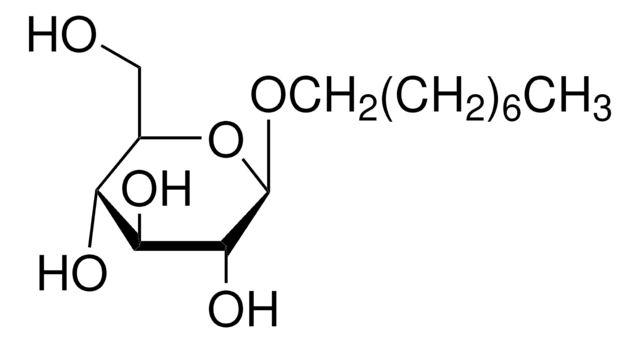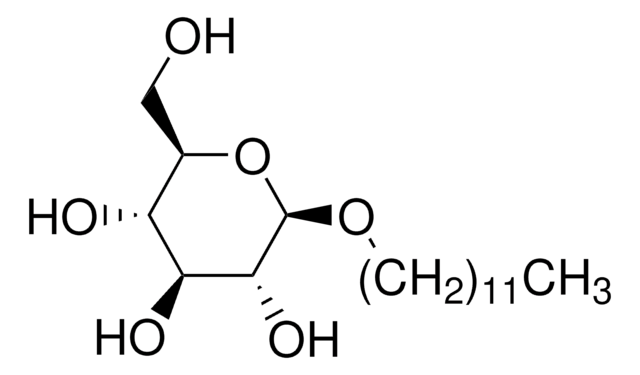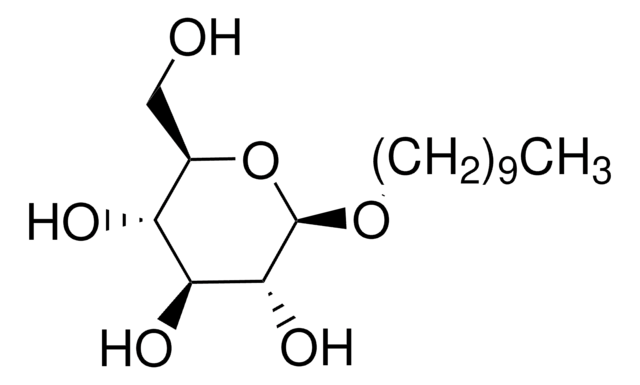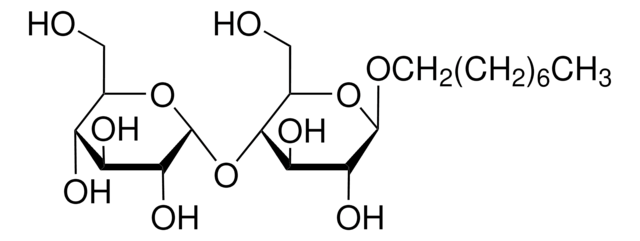10634425001
Roche
n-Octylglucoside
non-ionic
Sinonimo/i:
Octyl β-D-glucopyranoside, n-Octyl glucoside, OGP
About This Item
Prodotti consigliati
Saggio
99% (GC)
PM
micellar avg mol wt 25,000
292.4
Confezionamento
pkg of 10 g
Produttore/marchio commerciale
Roche
Numero d'aggregazione
84
tecniche
dialysis: suitable
CMC
20-25 mM (20-25°C)
Temp. transizione
cloud point >100 °C
Condizioni di spedizione
ambient
Stringa SMILE
CCCCCCCCO[C@@H]1O[C@H](CO)[C@@H](O)[C@H](O)[C@H]1O
InChI
1S/C14H28O6/c1-2-3-4-5-6-7-8-19-14-13(18)12(17)11(16)10(9-15)20-14/h10-18H,2-9H2,1H3/t10-,11-,12+,13-,14-/m1/s1
HEGSGKPQLMEBJL-RKQHYHRCSA-N
Cerchi prodotti simili? Visita Guida al confronto tra prodotti
Descrizione generale
Applicazioni
Qualità
Ease of removal*: ++
CMC**: 14.5 mM at +25°C
Formula: C14H28O6
Nota sulla preparazione
Working solution: Solubility: > 50% (w/v) in double-dist. water, Tris-HCl 0.05 mol/l; pH7.4 or K-phosphate buffer 0.1 mol/l, pH 7.0 at 25 °C.
Storage conditions (working solution): Stability in Solution
A stock solution is stable at 2 to 8 °C for approx. 3 days. We would expect a long term stability of 6-12 months if stored frozen in portions at -15 to -25 °C, provided bacterial contamination is avoided.
Stoccaggio e stabilità
Altre note
Codice della classe di stoccaggio
11 - Combustible Solids
Classe di pericolosità dell'acqua (WGK)
WGK 1
Punto d’infiammabilità (°F)
Not applicable
Punto d’infiammabilità (°C)
Not applicable
Scegli una delle versioni più recenti:
Possiedi già questo prodotto?
I documenti relativi ai prodotti acquistati recentemente sono disponibili nell’Archivio dei documenti.
I clienti hanno visto anche
Il team dei nostri ricercatori vanta grande esperienza in tutte le aree della ricerca quali Life Science, scienza dei materiali, sintesi chimica, cromatografia, discipline analitiche, ecc..
Contatta l'Assistenza Tecnica.











